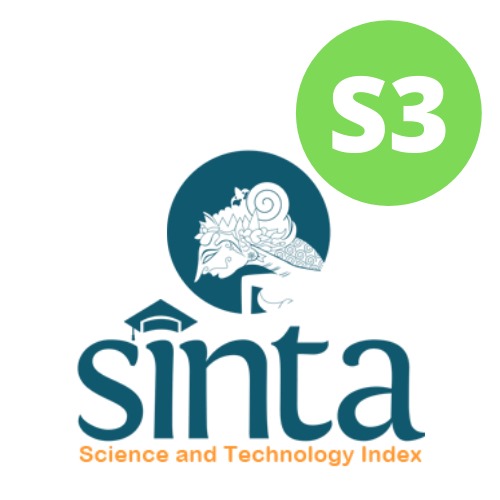Development of Low-Cost Electrospinning to Fabricate Structured Nanofiber for Biomedical Designs with Manageable Flowrate and Voltage
Abstract
Electrospinning is the most popular method that uses in nanofiber production. However, the budget to purchase this tool in the market is expensive. This article reports how to build electrospinning at a lesser cost. There are three main components in electrospinning that will be broken down regarding how to build it. First, the Syringe pump creates machinery to push the liquid in the syringe creating a Taylor cone affected by high voltage. Second, a high voltage power supply occurs electrostatic force. Third, the collector gathers nanofiber products. This machine has cost Rp 3.168.822 or $220,26. This number is less than the shop production or the previous report to create low-cost electrospinning. To make sure that this method successfully creates nanofiber. Scanning Electron Microscopy (SEM) is conducted and the result shows that the fiber size is 719±0,06 nanometers. Moreover, the flow rate and the voltage also have been assessed resulting that they are in a controllable manner by showing a linear profile. In this article, the budget is shared to declare that this electrospinning is more affordable. Hopefully, this report could help researchers who intend to build electrospinning at the lab scale to develop their research in nanofiber products with less cost
Downloads
References
T. Li, M. Sun, and S. Wu, “State-of-the-Art Review of Electrospun Gelatin-Based Nanofiber Dressings for Wound Healing Applications,” Nanomaterials, vol. 12, no. 5, p. 784, 2022.
B. Subia, J. Kundu, and S. C., “Biomaterial Scaffold Fabrication Techniques for Potential Tissue Engineering Applications,” Tissue Eng., no. 3, 2010.
K. Ghosal et al., “Electrospinning over Solvent Casting: Tuning of Mechanical Properties of Membranes,” Sci. Rep., vol. 8, no. 1, pp. 1–9, 2018.
Y. Chen et al., “Gas foaming of electrospun poly(L-lactide-co-caprolactone)/silk fibroin nanofiber scaffolds to promote cellular infiltration and tissue regeneration,” Colloids Surfaces B Biointerfaces, vol. 201, no. February, 2021.
R. D. Velasco Barraza, A. S. Álvarez Suarez, L. J. Villarreal Gómez, J. A. Paz González, A. L. Iglesias, and R. Vera Graziano, “Designing a low cost electrospinning device for practical learning in a Bioengineering Biomaterials course,” Rev. Mex. Ing. Biomed., vol. 37, no. 1, pp. 7–16, 2016.
M. Yusro and R. Martien, “Investigating Fluid Parameters in Nanofiber Biomaterial Fabrication using Electrospinning,” J. Energy, Mech. Mater. Manuf. Eng., vol. 5, no. 1, p. 11, 2020.
W. E. Teo and S. Ramakrishna, “A review on electrospinning design and nanofibre assemblies,” Nanotechnology, vol. 17, no. 14, 2006.
M. Yusro, “Assessing Beads Generation in Fabricating Nanofiber Bioactive Material-Based Associated with Its Fluid Factors,” Lect. Notes Electr. Eng., vol. 746 LNEE, no. 128, pp. 173–182, 2021.
W. Zuo, M. Zhu, W. Yang, H. Yu, Y. Chen, and Y. Zhang, “Experimental study on relationship between jet instability and formation of beaded fibers during electrospinning,” Polym. Eng. Sci., vol. 45, no. 5, pp. 704–709, 2005.
H. Abu Owida, B. Al-haj Moh’d, and M. Al Takrouri, “Designing an Integrated Low-cost Electrospinning Device for Nanofibrous Scaffold Fabrication,” HardwareX, vol. 11, p. e00250, 2022.
S. Zoha and S. A. Dayo, ““ Ultrasound Mediated Smart Drug Delivery System , a Noninvasive approach for the delivery of Insulin from Nanofiber,” vol. 04, no. 02, pp. 51–56, 2021.
H. A. Owida et al., “Recent Applications of Electrospun Nanofibrous Scaffold in Tissue Engineering,” Appl. Bionics Biomech., vol. 2022, 2022.
D. J. Lim, “Cross-Linking Agents for Electrospinning-Based Bone Tissue Engineering,” Int. J. Mol. Sci., vol. 23, no. 10, 2022.
M. Movahedi, A. O. M. Salehi, F. P. hajipour, and S. Etemad, “Casein release and characterization of electrospun nanofibres for cartilage tissue engineering,” Bull. Mater. Sci., vol. 45, no. 2, 2022.
B. Van de Voorde et al., “Electrospinning of poly(decamethylene terephthalate) to support vascular graft applications,” Eur. Polym. J., vol. 165, no. November 2021, 2022.
J. M. A. Mancipe, F. A. Lobianco, M. L. Dias, and R. M. da Silva Moreira Thiré, “Electrospinning: New Strategies for the Treatment of Skin Melanoma,” Mini-Reviews Med. Chem., vol. 22, no. 4, pp. 564–578, 2021.
Q. Nie, H. Chen, S. Li, X. Gao, Q. An, and H. Fang, “Simulations for Pulsating Breakups of a Nano Taylor Cone,” J. Phys. Conf. Ser., vol. 1995, no. 1, 2021.
A. Nguyen, “Hard Real-time Linux on a Raspberry Pi for 3D Printing Hard Real-time Linux on a Raspberry Pi for 3D Printing,” 2022.
B. Bednarski, K. Jackiewicz, and A. Gałecki, “Influence of microstepping signal shape on shaft movement precision and torque variation of the stepper motor,” Energies, vol. 14, no. 19, 2021.
B. Yan, Y. Zhang, Z. Li, P. Zhou, and Y. Mao, “Electrospun nanofibrous membrane for biomedical application,” SN Appl. Sci., vol. 4, no. 6, 2022.
D. A. Hapidin, I. Saleh, M. M. Munir, and Khairurrijal, “Design and Development of a Series-configuration Mazzilli Zero Voltage Switching Flyback Converter as a High-voltage Power Supply for Needleless Electrospinning,” Procedia Eng., vol. 170, pp. 509–515, 2017.
I. I. Cardenas Bates, É. Loranger, and B. Chabot, “Chitosan-PEO nanofiber mats for copper removal in aqueous solution using a new versatile electrospinning collector,” SN Appl. Sci., vol. 2, no. 9, pp. 1–14, 2020.
Y. Zhou, Z. Hu, D. Du, and G. Z. Tan, “The effects of collector geometry on the internal structure of the 3D nanofiber scaffold fabricated by divergent electrospinning,” Int. J. Adv. Manuf. Technol., vol. 100, no. 9–12, pp. 3045–3054, 2019.
N. Joy, R. Anuraj, A. Viravalli, H. N. Dixit, and S. Samavedi, “Coupling between voltage and tip-to-collector distance in polymer electrospinning: Insights from analysis of regimes, transitions and cone/jet features,” Chem. Eng. Sci., vol. 230, p. 116200, 2021.
Z. Arifin, S. Hadi, Suyitno, and S. D. Prasetyo, “ Characteristics of ZnO nanofiber in double Layer (TiO 2 / ZnO) DSSC results of direct deposition electrospinning manufacturing: Variation of tip to collector distance ,” IOP Conf. Ser. Mater. Sci. Eng., vol. 1034, no. 1, p. 012089, 2021.
M. E. Zin and W. Sutapun, “ Study of parameter affecting morphology of electrospun poly (lactic acid) (PLA) fibers loaded with Ag/CaCO 3 filler ,” IOP Conf. Ser. Mater. Sci. Eng., vol. 1234, no. 1, p. 012009, 2022.
X. Hu et al., “Synthesis of Hollow PVP/Ag Nanoparticle Composite Fibers via Electrospinning Under A Dense CO2 Environment,” Polymers (Basel)., vol. 14, no. 1, 2022.
F. Topuz, M. A. Abdulhamid, T. Holtzl, and G. Szekely, “Nanofiber engineering of microporous polyimides through electrospinning: Influence of electrospinning parameters and salt addition,” Mater. Des., vol. 198, p. 109280, 2021.
A. Ahmad et al., “Toothed wheel needleless electrospinning: a versatile way to fabricate uniform and finer nanomembrane,” J. Mater. Sci., vol. 54, no. 21, pp. 13834–13847, 2019.
Copyright (c) 2022 Muhammad Yusro, Kadarisman Kadarisman

This work is licensed under a Creative Commons Attribution-ShareAlike 4.0 International License.
Authors who publish with this journal agree to the following terms:
- Authors retain copyright and grant the journal right of first publication with the work simultaneously licensed under a Creative Commons Attribution-ShareAlikel 4.0 International (CC BY-SA 4.0) that allows others to share the work with an acknowledgement of the work's authorship and initial publication in this journal.
- Authors are able to enter into separate, additional contractual arrangements for the non-exclusive distribution of the journal's published version of the work (e.g., post it to an institutional repository or publish it in a book), with an acknowledgement of its initial publication in this journal.
- Authors are permitted and encouraged to post their work online (e.g., in institutional repositories or on their website) prior to and during the submission process, as it can lead to productive exchanges, as well as earlier and greater citation of published work (See The Effect of Open Access).








